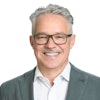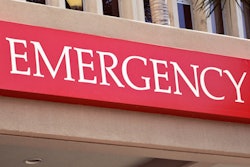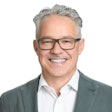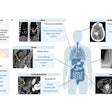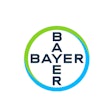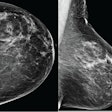The first meeting of the seven radiological societies making up the G7 bloc met in Venice, Italy, from October 10 to 13. The focus was on sustainability, AI and precision medicine, imaging the frail and elderly, workforce issues and burnout, and the future of radiology.
The RSNA represented the U.S., while other attendees came from the Canadian Association of Radiologists (CAR), the U.K. Royal College of Radiologists (RCR), the French Society of Radiology (SFR), the German Roentgen Society (DRG), the Italian Society of Medical Radiology (SIRM), the Japanese Radiological Society (JRS), and the European Society of Radiology (ESR).
 The Ateneo Veneto, founded in 1812 and the oldest cultural institute still operating in Venice, was chosen as the venue for "R7 – Radiology International Forum of Scientific Societies of Radiology." Photo courtesy of SIRM and Emanuele Neri, MD.
The Ateneo Veneto, founded in 1812 and the oldest cultural institute still operating in Venice, was chosen as the venue for "R7 – Radiology International Forum of Scientific Societies of Radiology." Photo courtesy of SIRM and Emanuele Neri, MD.
The meeting was the brainchild of SIRM President Andrea Giovagnoni, MD. Radiology needs to create a forum in which to discuss issues of strategic importance for the future of radiology that is outside the "frantic rhythms of conferences," he explained in an introduction to the rationale behind the new invitation-only meeting.
"Only through an informal meeting, outside of academic officialdom and the rigid rhythms of the conference, in a less 'constrained' atmosphere, can the conditions be found to be able to discuss more calmly and to reach a synthesis on issues of great importance that are the expression of a common programmatic agreement," he noted.
According to Giovagnoni, the choice of location was easy: Venice, a magical and unique city that was already chosen as the location for the first Italian G7 back in 1980. The societies were selected "on a nonstringent criteria" that reflected "the knowledge already expressed in the literature, statements, and documents," he said. Some nonradiologists were invited, and no financial support came from industry -- "hence the discussion can be more open, and freer from conflicts of interest," he added.
 Andrea Giovagnoni, MD, (center) and some of the key participants at the Venice meeting. Photo courtesy of SIRM and Emanuele Neri, MD.
Andrea Giovagnoni, MD, (center) and some of the key participants at the Venice meeting. Photo courtesy of SIRM and Emanuele Neri, MD.
Feedback from attendees
"The atmosphere was very relaxed, and it was held in a wonderful venue," ESR President Carlo Catalano, MD, told AuntMinnie.com on October 14. "All participants were enthusiastic because of the many discussions, even during social activities."
 Carlo Catalano, MD. Photo courtesy of Christof Pelz.
Carlo Catalano, MD. Photo courtesy of Christof Pelz.
Catalano's own presentation on the final day of the meeting focused on "The next generation of radiologists" -- a subject close to his heart, he said.
Having the time to be able to discuss the different global perspectives of these important topics at length was highly valuable, said RCR President Kath Halliday, MD. This was not only to share practice in different countries, learn from each other, and gain valuable understanding but also to look at where there is the possibility for international collaboration and leadership, she continued.
"Often we're too busy focusing on our national issues to take the time to fully understand what is happening in other countries, including what we can learn from them," Halliday said. "The advancement of radiology is a global endeavor, and working closely with our international colleagues on important issues is vital."
The aim now is to draft a preliminary report for a possible joint document, according to Giovagnoni. "Many ideas and proposals can be born within a relaxed atmosphere. They may come from outside the classrooms, at the table, or in front of one of the many wonders of art we are going to visit," he said.
He hopes that the meeting will be repeated, with Venice remaining as a possible fixed location. The overall plan is for the discussion of five fundamental themes to lead to the production of inter-society documents, which can then be an agenda and a point-of-reference for the future strategies of the global radiological community. At this stage, the objective is to formalize some white papers expressing the components of the presentations but without the direct formal approval of each society, Giovagnoni pointed out.
Interestingly, the G7 Health Ministers met in Ancona, Italy, from October 9 to 11, 2024. The G7 is an informal bloc of industrialized democracies -- the U.S., Canada, France, Germany, Italy, Japan, and the U.K. -- that meets annually to discuss issues such as global economic governance, international security, and AI. Proponents say the forum's small and relatively homogenous membership promotes collective decision-making, but critics note that it often lacks follow-through and excludes emerging powers.
 RSNA President Curtis P. Langlotz, MD, PhD, (left) with Emanuele Neri, MD, from Pisa.
RSNA President Curtis P. Langlotz, MD, PhD, (left) with Emanuele Neri, MD, from Pisa.
Russia belonged to the forum from 1998 to 2014, when the bloc was known as G8, but the country was suspended following its annexation of Ukraine's Crimea region.


